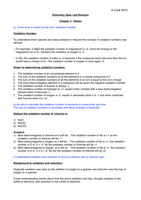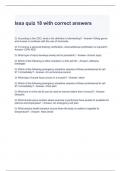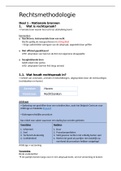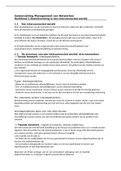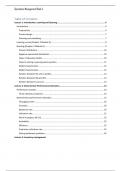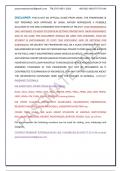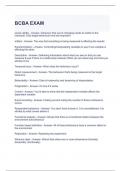Chemistry Spec Led Revision
Chapter 3 - Redox
a) know what is meant by the term ‘oxidation number’
Oxidation Number:
To understand which species are being oxidised or reduced the concept of oxidation numbers was
derived.
• For example, in MgO the oxidation number of magnesium is +2, since the charge on the
magnesium ion is 2+. Similarly the oxidation of oxygen is -2.
• In SO2 the oxidation number of sulfur is +4 because if the compound were fully ionic then the ion
would have a charge of 4+. The oxidation number of oxygen is once again -2.
Rules for determining oxidation numbers:
1. The oxidation number of an uncombined element is 0
2. The sum of the oxidation numbers of all the elements in a neutral compound is 0
3. The sum of the oxidation numbers of all the elements in an ion is equal to the ion’s charge
4. The more electronegative element in a substance will be given the negative oxidation number
5. The oxidation number of fluorine is always -1
6. The oxidation number of hydrogen is +1, expect when combed with a less electronegative
element when it becomes -1.
7. The oxidation number of oxygen is -2, expect in peroxides when it is -1 and when combined
with fluorine when it is +2.
b) be able to calculate the oxidation number of elements in compounds and ions
The use of oxidation numbers in peroxides and metal hydrides is expected.
Deduce the oxidation number of chlorine in:
1) NaCl
2) NaClO
3) NaClO3
Answers
1) Most electronegative is chlorine so it will be -. The oxidation number of Na is +1 so the
oxidation number of chlorine will be -1.
2) Most electronegative is oxygen so it will be -. The oxidation number of Na is +1, the oxidation
number of O is -2 = -2. So the oxidation number of chlorine will be +1
3) Most electronegative is oxygen, so it will be -. The oxidation number of Na is +1, the oxidation
number of O is -2 x 3 = -6. So the the oxidation number of chlorine will be +5
c) Understand oxidation and reduction in terms of electron loss or electron gain
Background to oxidation and reduction:
Originally oxidation was seen as the addition of oxygen to a species and reduction was the loss of
oxygen to a species.
A new understanding comes about from the terms oxidation and loss, through oxidation is the
GAIN of electrons, and reduction is the LOSS of electrons.

